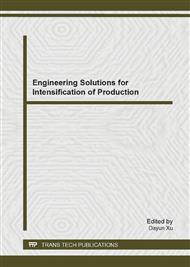[1]
Ali Lasemi, Deyi Xue, Peihua Gu, Recent development in CNC machining of freeform surfaces, A state-of-the-art review, Computer Aided Design. 42 (2010) 641-654.
DOI: 10.1016/j.cad.2010.04.002
Google Scholar
[2]
Dr J. G. Chow, Reproducing aircraft structural components using laser scanning, The International Journal of Advanced Manufacturing Technology. 13 (1997) 723-728.
DOI: 10.1007/bf01179072
Google Scholar
[3]
Choi BK, Surface modeling for CAD/CAM, Kluwer Academic Publishers, London, (1991).
Google Scholar
[4]
Choi BK, Kim DH, Jerard RB, C-space approach to tool-path generation for die and mould machining, Computer-Aided Design. 29 (1997) 657-69.
DOI: 10.1016/s0010-4485(97)00012-2
Google Scholar
[5]
Cha Soo Juna, Dong Soo Kima, Sehyung Parkb, A new curve-based approach to polyhedral machining, Computer-Aided Design. 34 (2002) 379-389.
DOI: 10.1016/s0010-4485(01)00110-5
Google Scholar
[6]
Su-Jin Kim, Min-Yang Yang, Triangular mesh offset for generalized cutter, Computer Aided Design. 37 (2005) 999-1014.
DOI: 10.1016/j.cad.2004.10.002
Google Scholar
[7]
Farouki,R. T, Exact offset procedures for simple solid, Computer Aided Design. 2 (1985) 257-279.
DOI: 10.1016/s0167-8396(85)80002-9
Google Scholar
[8]
Jun C S, Kim D S, Park S H, A new curve- based approach to polyhedral machining, Computer Aided Design. 34 (2002) 379- 389.
DOI: 10.1016/s0010-4485(01)00110-5
Google Scholar
[9]
Yongfu Ren. Computational techniques to improve efficiency and accuracy for high performance machining of polyhedral models. North Carolina State University (2002).
Google Scholar
[10]
Dong-Jin Yool, General 3D offsetting of a triangular net using an implicit function and the distance fields, International journal of precision engineering and manufacturing. 10(2009) 131-142.
DOI: 10.1007/s12541-009-0081-5
Google Scholar
[11]
Sheng jun Liu, Charlie C.L. Wang. Fast intersection-free offset surface generation from freeform models with triangular meshes, Transactions on automation science and engineering. 8(2011) 347-360.
DOI: 10.1109/tase.2010.2066563
Google Scholar
[12]
Chen Yong, Wang CL. Uniform offsetting of polygonal model based on Layered Depth-Normal Images, Computer Aided Design. 43(2011) 31-46.
DOI: 10.1016/j.cad.2010.09.002
Google Scholar
[13]
WenYu Yang, WenQiang Hu, YouLun Xiong. A Deformable Mesh Model Based on Convex Hull of Scattered Points, China Mechanical Engineering. 15(2004) 2040-(2043).
Google Scholar
[14]
GuiPin Qian, Research on Mesh Reconstruction and Repair from Scattered Point Cloud. Zhejiang University. Computer Science and Technology (2008).
Google Scholar
[15]
Gregory E. Fasshauer, Toward approximate moving least squares approximation with irregularly spaced centers, Computer methods in applied Mechanics and engineering. 193 (2004) 1231-1243.
DOI: 10.1016/j.cma.2003.12.017
Google Scholar
[16]
Soo-Kyun Kim, Chang-Hun Kim, Finding ridges and valleys in a discrete surface using a modified MLS approximation, Computer Aided Design. 37(2005) 1533-1542.
DOI: 10.1016/j.cad.2005.05.002
Google Scholar


